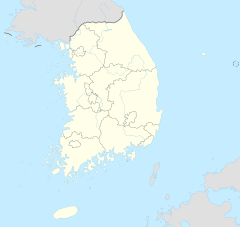Daegwallyeong-myeon facts for kids
Quick facts for kids
Daegwallyeong-myeon
대관령면
|
|
|---|---|
|
Township
|
|
| Korean transcription(s) | |
| • Hangul | 대관령면 |
| • Hanja | 大關嶺面 |
| Country | |
| Province | Gangwon-do |
| County | Pyeongchang |
| Administrative divisions | 21 ri |
| Area | |
| • Total | 221.6 km2 (85.6 sq mi) |
| Elevation | 750 m (2,460 ft) |
| Population
(2008)
|
|
| • Total | 6,162 |
| Time zone | UTC+9 |
Daegwallyeong-myeon is a special area, like a township, located in Pyeongchang County in South Korea. It's found in the northeastern part of Pyeongchang, which is in Gangwon-do, a province in South Korea. In 2008, about 6,162 people lived there.
Until 2007, this area was called Doam-myeon. Its current name, Daegwallyeong-myeon, comes from an important mountain pass called Daegwallyeong. This area is known for having the coldest average temperature in South Korea.
Contents
History of Daegwallyeong-myeon
Daegwallyeong-myeon was originally part of the city of Gangneung. In 1906, it became part of Jeongseon county. Later, in 1931, it joined Pyeongchang county.
The area was known as Doam-myeon for a long time. It was renamed Daegwallyeong-myeon because of the Daegwallyeong mountain pass. This pass connects the area to Gangneung. Because of this connection, Daegwallyeong-myeon feels more linked to Gangneung than to other parts of Pyeongchang.
Divisions of Daegwallyeong-myeon
Daegwallyeong-myeon is divided into 21 smaller areas. These areas are called ri. A ri is like a small village or administrative unit in South Korea.
Here are the 21 divisions:
- Hoenggye 1 to 13 - ri (Korean: 횡계리; Hanja: 橫溪里 1~13리)
- Chahang 1 to 2 - ri (Korean: 차항리; Hanja: 車項里 1~2리)
- Suhari (Korean: 수하리; Hanja: 水下里)
- Yongsan 1 to 2 - ri (Korean: 용산리; Hanja: 龍山里 1~2리)
- Yucheon 1 to 3 - ri (Korean: 유천리; Hanja: 楡川里 1~3리)
- Byungnaeri (Korean: 병내리; Hanja: 屛內里)
Climate in Daegwallyeong-myeon
Daegwallyeong-myeon has a temperate climate. This means it has four distinct seasons. The average temperature throughout the year is about 6.6 degrees Celsius.
The warmest month is August, with temperatures around 19.1 degrees Celsius. The coldest month is January, where temperatures can drop to about -7.7 degrees Celsius. The lowest temperature ever recorded was -28.9 degrees Celsius in January.
This area gets a lot of rain, especially in summer. The average rainfall is about 1898 millimeters a year. July is the wettest month, with around 326.7 millimeters of rain. December is the driest month, getting about 36.8 millimeters of rain.
It also snows quite a bit. Daegwallyeong-myeon sees snow for about 57 days each year. January has the most snow days, with around 13 days of snow.
Fun Places to Visit
Daegwallyeong-myeon has several exciting places to visit. Many of these are famous for winter sports.
- Yongpyong Ski Resort
- This is the biggest ski resort in South Korea.
- It was one of the places where events for the 2018 Winter Olympics were held.
- Alpensia Resort
- This resort was the main location for the 2018 Winter Olympics.
- Most of the sporting events took place here.
- Pyeongchang Olympic Stadium
- This stadium was used for the opening and closing ceremonies of the 2018 Winter Olympics.
Pyeongchang was chosen to host the 2024 Winter Youth Olympics on January 10, 2020. Daegwallyeong-myeon will also be a big part of this event. The same facilities used for the 2018 Winter Olympics will be used again. They will likely host similar sports and ceremonies for the youth games.
See also
 In Spanish: Daegwallyeong-myeon para niños
In Spanish: Daegwallyeong-myeon para niños


